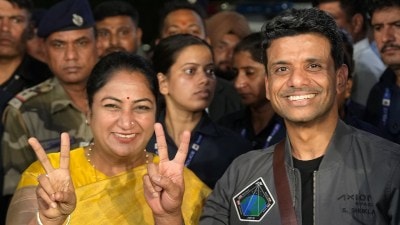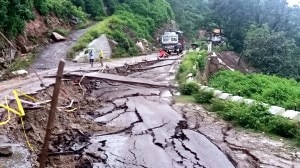Stay updated with the latest - Click here to follow us on Instagram
Unsung Heroes: How an NGO by passionate environmentalists fights for green, social causes
Environment Support Group has been working for the rights of marginalised communities, including ‘pourakarmikas’ in Karnataka (workers involved in cleaning public spaces) and street vendors, and protecting water bodies, etc.
 Bhargavi S. Rao has more than 30 years of experience across research, advocacy, campaign, and teaching in a variety of human rights, governance, and people-centered initiatives, and in advancing environmental and social justice.
Bhargavi S. Rao has more than 30 years of experience across research, advocacy, campaign, and teaching in a variety of human rights, governance, and people-centered initiatives, and in advancing environmental and social justice. For 25 years, Bengaluru-based non-governmental organisation Environment Support Group (ESG) has been involved in environmental and social justice initiatives across India.
ESG took shape as a result of the socio-economic and environmental upheaval that was adversely affecting dozens of communities in the Dakshina Kannada region due to reckless industrialisation and urbanisation, says Leo F. Saldanha, the full-time coordinator. Saldanha is assisted by Bhargavi S. Rao, who works as a trustee and senior fellow with the NGO that had its informal launch in 1996.
“Working with the ‘Save Dakshina Kannada Campaign’, we managed to stop several disastrous projects. Sometimes we failed to prevent disasters, as in the case of the 2010 air crash at Mangalore airport, which shockingly occurred in the same way as we warned a decade before,” said Saldanha, while explaining the reasons to start ESG as certain issues needed dedicated and regular attention.
After the organisation was formally registered as a Public Charitable Trust in 1998, it worked among a huge spectrum of communities spread across Dandeli in Karnataka to Loktak in Manipur, from Odisha to Kerala. The group struggled to secure the rights of marginalised communities, including ‘pourakarmikas’ in Karnataka (workers involved in cleaning public spaces) and street vendors, protect and rehabilitate water bodies, etc.
“Such experiences have been deeply humbling,” recalls Saldanha, who was passionately involved in a variety of social and environmental causes in his school and college days.
“During my school and junior college, I was active in the Young Students Movement that helped in shaping my politics. Thereafter, I found myself involved in more issues of the common man and land as I took up Environmental Science,” says Saldanha, who got involved in the fight against Kaiga nuclear plant in Western Ghats, Narmada Bachao Andolan, child labour, worked for decentralisation of governance, greater federalism, rights of street children, and worked with leprosy patients.
“This gave me the opportunity of working closely with eminent persons such as Dr. K. Shivarama Karanth, Medha Patkar, Prof. M. D. Nanjundaswamy, Dr. Vandana Shiva, Fr. Stan Swamy, Sr. Mary Mascarenhas, all of whom had tirelessly worked with the most vulnerable sections of society and consistently raised voices against destructive development,” he says.
Saldanha was largely influenced by his grandfather, an illiterate farmer and tailor in Kodagu, who helped shape his environmental consciousness. “He taught me, my siblings and cousins about what it is to celebrate living on this biodiversity-rich planet, and always asked us to ensure that future generations get their due.”
Bhargavi S. Rao has more than 30 years of experience across research, advocacy, campaign, and teaching in a variety of human rights, governance, and people-centered initiatives, and in advancing environmental and social justice. As a trustee of ESG, she contributes to legal and investigative research and represents the organisation in public interest litigation (PILs) pertaining to lake protection and other environmental and social justice causes.
Recalling her foray in environmental issues, Rao says, “In class 12, as we know everybody is in the rat race of getting into engineering or medicine and enrolling themselves into special tuitions to get high ranking in CET. I stayed away from all of that, much to the disappointment of my parents. I was very clear I would not take up medicine or engineering but I would do something different. Also, early childhood influences have played a great role in shaping my decisions to take up this field. For example, simple things like I grew up in a house that had a beautiful garden all around. My grandparents’ house had a beautiful garden and that is where my early bonding with nature commenced. Also, I stayed close to Lalbagh (botanical garden) where my parents used to take me,” Rao says.
In her high school days Rao recalls that there were a lot of summer programmes, which were supported by the Karnataka Rajya Vijnana Parishat (a government-run body, autonomous, but financed by the Karnataka government to help raise the scientific temper in the students) which exposed the students to a lot of challenges at that point of time. “During school days, I remember visiting a couple of forest patches and also the Vrishabhavathi River which by then had already started receiving a lot of the city’s sewage waters. So all this had left a very big mark on me and stayed with me,” she says.
After pursuing an undergraduate programme in environmental science from St Joseph’s College, Bengaluru, Rao obtained her Master’s in Botany with specialisation in microbiology. “Later on, I did MPhil in Botany, again with specialisation in aerobiology and this gave me a whole different perspective of the city,” says Rao who took up a research assistant job at the Indian Institute of Science (IISc) at the department of Microbiology and Cell Biology. “There I was working on a project where they were trying to find a vaccine for the rotavirus infection that affects neonates, particularly in countries like ours. After a couple of years into being a research assistant, I was wondering if a vaccine or clean drinking water is the answer to diarrhea as diarrhea is just one of the symptoms of the rotavirus infection. I wanted to engage with something deeper and more meaningful and this helped me move forward and away from being in a lab for the rest of my life,” Rao explains.
In 1998, while attending a workshop on environmental challenges of Bangalore organised by ESG, Rao knew what she wanted to do.
“ESG was set up by my classmates, Leo Saldanha, Robert John Chandran and a couple of others. This really transformed many things in my life because I got to see exactly where the problems were. I said to myself that this is what I wanted to do and started volunteering with the ESG and then I got fully associated with it. It has been two-and-a-half decades but it feels like that workshop is still on and every day we come across new challenges, trying to figure out how we can engage with it,” she elaborates.
Over the past many years, ESG has achieved major milestones in conserving water, addressing issues of waste management, and arguing for the rights of pourakarmikas or safai karamcharis in Bengaluru.
Elaborating on this, Saldanha says, “A significant milestone is of constructing a methodology of conserving water commons, and thus all commons, by securing path-breaking judicial directives to constitute district and municipal lake Protection committees, thus making the forum accessible to all within their districts.”
Similarly, the organisation has worked to critique environmental law and policy, be that in arguing against the dilution of progressive environmental norms and laws, or proposing deeply democratic and accountable environmental decision-making. Each and every bit of ESG’s work with communities and social and environmental justice issues is documented and shared publicly, and this has helped win the appreciation of public administration, corporations, and academia.
“We have consistently advocated how disparities in economic development are manifestations of dispossession of everyone’s due right to healthy living, which is impossible in a contaminated and displeasing environment. We have argued for the dignity and rights of ‘Pourakarmikas’, fisher folks and forest inhabitants, and agro-pastoral communities’ inclusive access to commons as fundamental to living well, and to acknowledge that the means of production should never be predicated on the concentration of wealth in the hands of a few – a major constitutional directive,” Saldanha says.
He also credits the judiciary for playing a remarkable role in responding to a petition by ESG where the Karnataka High Court provided a framework of decentralised governance of public water bodies.
“The Karnataka High Court has played a remarkable and historic role in responding to ESG’s Lakes PIL (WP 817/2008) and provided a framework of ‘wise use’, inclusive, decentralised, governance of water commons. This resulted in the establishment of a statutory Karnataka Tank Conservation and Development Authority (KTCDA), a key regulator of water commons that is unprecedented and could serve as an example for all other regions of the world to emulate,” Saldanha says.
The court had agreed with ESG that the people and local communities must be assisted in protecting, conserving and rehabilitating lakes, tanks, raja kaluves, etc, locally, and ordered the constitution of the district or municipal lake protection committee as a remarkable outcome.
“Similarly, through initiatives in improving urban governance, ESG’s PIL has been the basis for the court directing the government to institute ward committees, so that people are able to fully enjoy their sovereign rights to a reasonably good quality of life, in much the same way. The ESG has worked to expose biopiracy by Monsanto and others, and in a first for the world, the company (now owned by Bayer) has been held accountable on criminal charges,” Saldanha adds.







